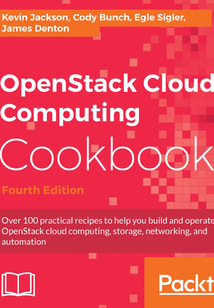舉報 

會員
OpenStack Cloud Computing Cookbook(Fourth Edition)
最新章節:
Index
Thisbookiswrittenforcloudsystemengineers,systemadministrators,andtechnicalarchitectswhoaremovingfromavirtualizedenvironmenttocloudenvironments.Thisbookassumesthatyouarefamiliarwithcloudcomputingplatforms,andhaveknowledgeofvirtualization,networking,andmanagingLinuxenvironments.
目錄(148章)
倒序
- coverpage
- OpenStack Cloud Computing Cookbook Fourth Edition
- www.mapt.io
- Why subscribe?
- PacktPub.com
- Contributors
- About the authors
- About the reviewers
- Packt is searching for authors like you
- Preface
- Who this book is for
- What this book covers
- To get the most out of this book
- Sections
- Get in touch
- Chapter 1. Installing OpenStack with Ansible
- Introduction – the OpenStack architecture
- Host network configuration
- Root SSH keys configuration
- Installing Ansible playbooks and dependencies
- Configuring the installation
- Running the OpenStack-Ansible playbooks
- Troubleshooting the installation
- Manually testing the installation
- Modifying the OpenStack configuration
- Virtual lab - vagrant up!
- Chapter 2. The OpenStack Client
- Introduction – using OpenStack
- Installing Python on Windows
- Installing the OpenStack clients
- Configuring your Linux or macOS environment
- Configuring your Windows environment
- Common OpenStack networking tasks
- Common OpenStack server (instances) tasks
- Common OpenStack image tasks
- Common OpenStack identity tasks
- Common OpenStack storage tasks
- Common OpenStack orchestration tasks
- Chapter 3. Keystone – OpenStack Identity Service
- Introduction – OpenStack Identity
- Creating OpenStack domains in Keystone
- Enabling domains in the OpenStack dashboard
- Creating OpenStack projects in Keystone
- Configuring roles in Keystone
- Adding users in Keystone
- Configuring groups in Keystone
- Deleting projects
- Deleting users
- Deleting roles
- Deleting groups
- Deleting domains
- OpenStack endpoint information
- Chapter 4. Neutron – OpenStack Networking
- Introduction to OpenStack networking
- Managing networks subnets and ports
- Creating provider networks
- Creating tenant networks
- Creating ports
- Updating network attributes
- Deleting ports
- Deleting networks
- Managing routers and floating IPs
- Attaching networks to routers
- Creating and assigning floating IPs
- Deleting routers
- Managing security groups
- Managing load balancers
- Chapter 5. Nova – OpenStack Compute
- Introduction to OpenStack Compute
- Adding a compute host using OpenStack-Ansible
- Suspending a host for maintenance
- Configuring Nova Scheduler to use host aggregates
- Creating a host aggregate
- Adding a compute host to a host aggregate
- Removing a compute host from a host aggregate
- Adding metadata to a host aggregate
- Deleting a host aggregate
- Creating an Availability Zone
- Booting an instance into an Availability Zone
- Removing an Availability Zone
- Creating a flavor
- Deleting a flavor
- Setting CPU limits for a flavor
- Setting IOPS limits for a flavor
- Booting an instance
- Stopping an instance
- Deleting an instance
- Live migration
- Snapshotting an instance
- Booting an instance from a snapshot
- Rescuing an instance
- Shelving an instance
- Reviewing the console logs
- Chapter 6. Glance – OpenStack Image Service
- Introduction to OpenStack Image services
- Managing images
- Using image snapshots
- Using image metadata
- Protecting images
- Deactivating images
- Creating custom images
- Chapter 7. Cinder – OpenStack Block Storage
- Introduction
- Configuring Cinder volume services
- Creating volumes
- Attaching volumes to an instance
- Detaching volumes from an instance
- Deleting volumes
- Working with volume snapshots
- Configuring volume types
- Enabling volume encryption
- Configuring volume Quality of Service (QoS)
- Resetting volume state
- Chapter 8. Swift – OpenStack Object Storage
- Introduction – OpenStack Object Storage
- Creating object containers
- Deleting object containers
- Uploading objects
- Uploading large objects
- Downloading objects
- Deleting objects
- Container ACLs
- Chapter 9. OpenStack Orchestration Using Heat and Ansible
- Introduction – orchestrating with OpenStack
- Creating your first stack
- Launching your stack with Heat
- Viewing the resources and output of a stack created with Heat
- Deleting a Heat stack
- Updating a Heat stack
- Installing and configuring Ansible for OpenStack
- Using Ansible to launch instances
- Using Ansible to orchestrate software installation
- Using Ansible to orchestrate software installations across multiple instances
- Using Ansible to fully orchestrate the creation of a web server and load balancer stack
- Chapter 10. Using OpenStack Dashboard
- Introduction – OpenStack Dashboard
- Using OpenStack Dashboard for key management
- Using OpenStack Dashboard to manage Neutron networks and routers
- Using OpenStack Dashboard for security group management
- Using OpenStack Dashboard to launch instances
- Using OpenStack Dashboard to delete instances
- Using OpenStack Dashboard to add new projects
- Using OpenStack Dashboard for user management
- Using OpenStack Dashboard with LBaaS
- Using OpenStack Dashboard with OpenStack Orchestration
- Another Book You May Enjoy
- Leave a review – let other readers know what you think
- Index 更新時間:2021-07-02 16:25:45
推薦閱讀
- 少兒人工智能趣味入門:Scratch 3.0動畫與游戲編程
- 一步一步學Spring Boot 2:微服務項目實戰
- 零基礎搭建量化投資系統:以Python為工具
- Learning PostgreSQL
- Web交互界面設計與制作(微課版)
- Windows Server 2012 Unified Remote Access Planning and Deployment
- INSTANT Mercurial SCM Essentials How-to
- 用Python實現深度學習框架
- Windows內核編程
- Bootstrap 4 Cookbook
- Mastering Linux Security and Hardening
- Kotlin開發教程(全2冊)
- Mastering Docker
- jQuery技術內幕:深入解析jQuery架構設計與實現原理
- 大數據時代的企業升級之道(全3冊)
- Python預測分析實戰
- SFML Game Development
- Offer來了:Java面試核心知識點精講(框架篇)
- Cloud Native Python
- MATLAB信號處理與應用
- 編程改變生活:用Python提升你的能力(基礎篇·微課視頻版)
- 機器學習全解(R語言版)
- 電子系統設計基礎
- PhoneGap Essentials
- Mastering Application Development with Force.com
- 基于Kotlin的Spring Boot微服務實戰
- Kali Linux 2:Assuring Security by Penetration Testing(Third Edition)
- Spring Cloud Alibaba 微服務原理與實戰
- 超級軟件:下一代互聯網云平臺
- Python程序設計基礎

